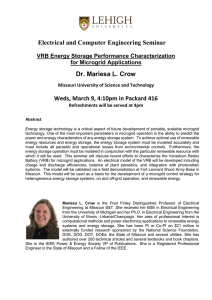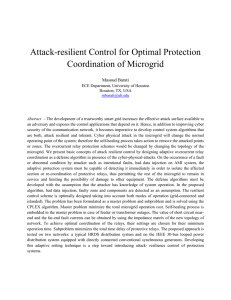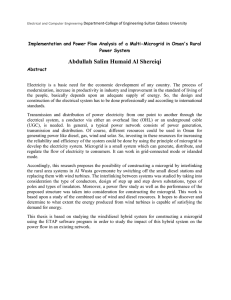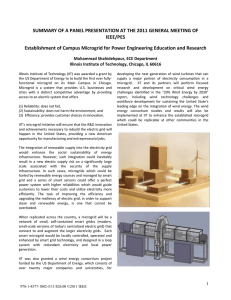IRJET-DC Micro Grid for Wind and Solar Electric System Power Integration
advertisement
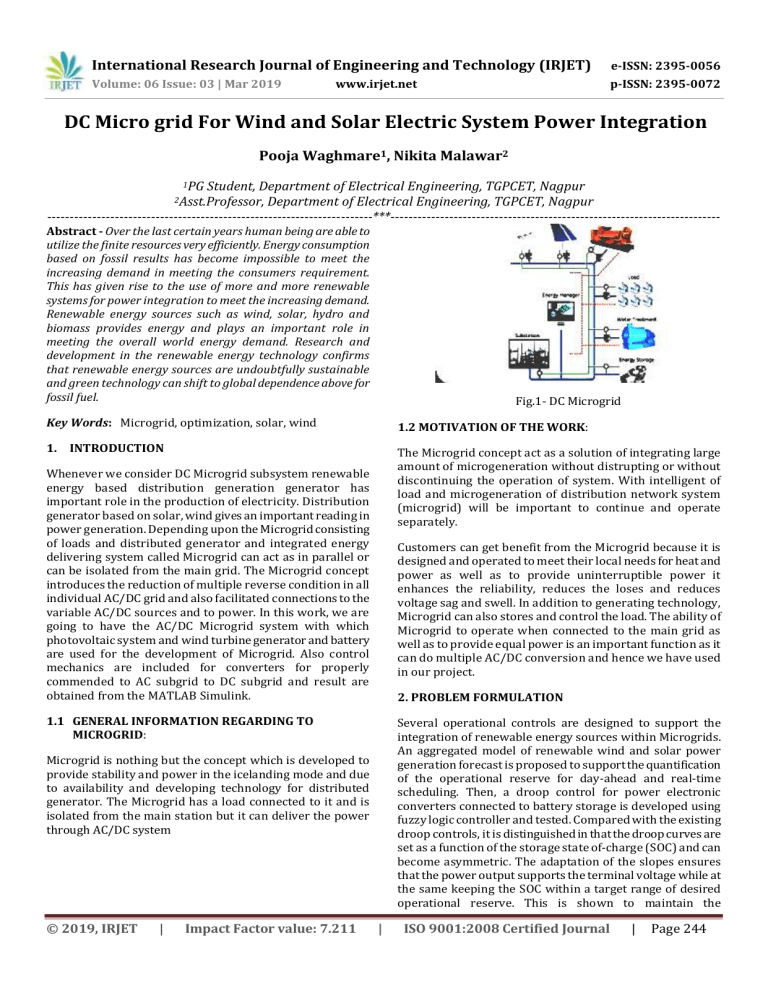
International Research Journal of Engineering and Technology (IRJET) e-ISSN: 2395-0056 Volume: 06 Issue: 03 | Mar 2019 p-ISSN: 2395-0072 www.irjet.net DC Micro grid For Wind and Solar Electric System Power Integration Pooja Waghmare1, Nikita Malawar2 1PG Student, Department of Electrical Engineering, TGPCET, Nagpur Department of Electrical Engineering, TGPCET, Nagpur ------------------------------------------------------------------------***------------------------------------------------------------------------2Asst.Professor, Abstract - Over the last certain years human being are able to utilize the finite resources very efficiently. Energy consumption based on fossil results has become impossible to meet the increasing demand in meeting the consumers requirement. This has given rise to the use of more and more renewable systems for power integration to meet the increasing demand. Renewable energy sources such as wind, solar, hydro and biomass provides energy and plays an important role in meeting the overall world energy demand. Research and development in the renewable energy technology confirms that renewable energy sources are undoubtfully sustainable and green technology can shift to global dependence above for fossil fuel. Fig.1- DC Microgrid Key Words: Microgrid, optimization, solar, wind 1.2 MOTIVATION OF THE WORK: 1. INTRODUCTION The Microgrid concept act as a solution of integrating large amount of microgeneration without distrupting or without discontinuing the operation of system. With intelligent of load and microgeneration of distribution network system (microgrid) will be important to continue and operate separately. Whenever we consider DC Microgrid subsystem renewable energy based distribution generation generator has important role in the production of electricity. Distribution generator based on solar, wind gives an important reading in power generation. Depending upon the Microgrid consisting of loads and distributed generator and integrated energy delivering system called Microgrid can act as in parallel or can be isolated from the main grid. The Microgrid concept introduces the reduction of multiple reverse condition in all individual AC/DC grid and also facilitated connections to the variable AC/DC sources and to power. In this work, we are going to have the AC/DC Microgrid system with which photovoltaic system and wind turbine generator and battery are used for the development of Microgrid. Also control mechanics are included for converters for properly commended to AC subgrid to DC subgrid and result are obtained from the MATLAB Simulink. Customers can get benefit from the Microgrid because it is designed and operated to meet their local needs for heat and power as well as to provide uninterruptible power it enhances the reliability, reduces the loses and reduces voltage sag and swell. In addition to generating technology, Microgrid can also stores and control the load. The ability of Microgrid to operate when connected to the main grid as well as to provide equal power is an important function as it can do multiple AC/DC conversion and hence we have used in our project. 2. PROBLEM FORMULATION 1.1 GENERAL INFORMATION REGARDING TO MICROGRID: Several operational controls are designed to support the integration of renewable energy sources within Microgrids. An aggregated model of renewable wind and solar power generation forecast is proposed to support the quantification of the operational reserve for day-ahead and real-time scheduling. Then, a droop control for power electronic converters connected to battery storage is developed using fuzzy logic controller and tested. Compared with the existing droop controls, it is distinguished in that the droop curves are set as a function of the storage state of-charge (SOC) and can become asymmetric. The adaptation of the slopes ensures that the power output supports the terminal voltage while at the same keeping the SOC within a target range of desired operational reserve. This is shown to maintain the Microgrid is nothing but the concept which is developed to provide stability and power in the icelanding mode and due to availability and developing technology for distributed generator. The Microgrid has a load connected to it and is isolated from the main station but it can deliver the power through AC/DC system © 2019, IRJET | Impact Factor value: 7.211 | ISO 9001:2008 Certified Journal | Page 244 International Research Journal of Engineering and Technology (IRJET) e-ISSN: 2395-0056 Volume: 06 Issue: 03 | Mar 2019 p-ISSN: 2395-0072 www.irjet.net equilibrium of the Microgrids real-time supply and demand. The controls are implemented for the special case of a DC Microgrid that is vertically integrated within a high-rise host building of an urban area. Previously untapped wind and solar power are harvested on the roof and sides of a tower, thereby supporting delivery to electric vehicles on the ground. The Microgrid vertically integrates with the host building without creating a large footprint. 4. SIMULATION 3. RESEARCH METHODOLOGY A schematic of the DC Microgrid with the conventions employed for power is given in Fig. 2. The dc bus connects wind energy conversion system (WECS), PV panels, multilevel energy storage comprising battery energy storage system (BESS) and super capacitor, EV smart charging points, EV fast charging station, and grid interface. The WECS is connected to the dc bus via an AC-DC converter. PV panels are connected to the dc bus via a dc–dc converter. The BESS can be realized through flow battery technology connected to the dc bus via a dc–dc converter. The super capacitor has much less energy capacity than the BESS. Rather, it is aimed at compensating for fast fluctuations of power and so provides cache control as detailed in. Thanks to the multilevel energy storage, the intermittent and volatile renewable power outputs can be managed, and a deterministic controlled power to the main grid is obtained by optimization. Providing uninterruptible power supply (UPS) service to loads when needed is a core duty of the urban micro grid. EV fast charging introduces a stochastic load to the Microgrid. The multilevel energy storage mitigates potential impacts on the main grid. 5. RESULTS 6. CONCLUSION In sum, this paper contributes to the Microgrid paradigm by a novel droop control that takes into account storage SOC when adaptively setting the slopes of the voltage–power droop curves; the proposed forecast based on aggregation of renewable power generation contributes to quantifying energy reserve. In an urban setting, a tower-integrated installation to co-locate harvesting of wind energy and local delivery of clean energy is an alternative. The optimization for power exchanges and dc voltage control using adaptive control are performed through power electronic converters that serve as interfaces to all resources. REFERENCES [1] Kai Strunz, EhsanAbbasi, and Duc Nguyen Huu, “DC Microgrid for Wind and Solar Power Integration”, IEEE Journal of emerging and selected topics in Power Electronics, vol. 2, no. 1, March 2014. Fig.2- Layout of DC Microgrid A DC micro grid for renewable power integration has been proposed. The operational optimization and powerelectronics based voltage–power droop control was developed, and the functioning was demonstrated through simulation. Interaction with the main grid was controlled as a result of an operational optimization that seeks to minimize cost and emissions. [2] Ujwala S. Raut, Y. D. Shahakar, “Optimization of Microgrid for Renewable Power Integration” International Advanced Research Journal in Science, Engineering and Technology, vol. 4, Issue 2, Feb 2017. [3] DurgaVijayalakshmi, M. D. Aijaz, “Dc Microgrid For Wind & Solar Power Integration” International Journal Of Engineering In Advanced Research Science And Technology, vol -2 , Issue-4, Dec.2016 © 2019, IRJET | Impact Factor value: 7.211 | ISO 9001:2008 Certified Journal | Page 245 International Research Journal of Engineering and Technology (IRJET) e-ISSN: 2395-0056 Volume: 06 Issue: 03 | Mar 2019 p-ISSN: 2395-0072 www.irjet.net [4] H. Polinder, J. A. Ferreira, B. B. Jensen, A. B. Abrahamsen, [15] A. Chaouachi, R. M. Kamel, R. Andoulsi, and K. Nagasaka, K. Atallah, and R. A. McMahon, “Trends in wind turbine generator systems,” IEEE J. Emerg. Sel. Topics Power Electron,vol. 1, no. 3, pp. 174–185, Sep. 2013. “Multiobjective intelligent energy management for a microgrid,” IEEE Trans.Ind. Electron., vol. 60, no. 4, pp. 1688–1699, Apr. 2013 [5] F. Giraud and Z. M. Salameh, “Steady-state performance of a grid connected rooftop hybrid wind photovoltaic power system with battery storage,” IEEE Trans. Energy Convers., vol. 16, no. 1, pp. 1–7, Mar. 2001. [6] ] B. S. Borowy and Z. M. Salameh, “Methodology for optimally sizing the combination of a battery bank and PV array in a wind/PV hybrid system,” IEEE Trans. Energy Convers., vol. 11, no. 2, pp. 367– 375, Mar. 1996.. [7] M. Cheng, S. Kato, H. Sumitani, and R. Shimada, “Flywheel-based AC cache power for stand-alone power systems,” IEEJ Trans. Electr. Electron. Eng., vol. 8, no. 3, pp. 290–296, May 2013. [8] H. Louie and K. Strunz, “Superconducting magnetic energy storage (SMES) for energy cache control in modular distributed hydro genelectric energy systems,” IEEE Trans. Appl. Supercond., vol. 17, no. 2, pp. 2361– 2364, Jun. 2007. [9] A. L. Dimeas and N. D. Hatziargyriou, “Operation of a multiagent system for Microgrid control,” IEEE Trans. Power Syst., vol. 20, no. 3, pp. 1447–1455, Aug. 2005. [10] F. Katiraei and M. R. Iravani, “Power management strategies for a microgrid with multiple distributed generation units,” IEEE Trans. Power Syst., vol. 21, no. 4, pp. 1821–1831, Nov. 2006. [11] A. G. Madureira and J. A. Pecas Lopes, “Coordinated voltage support in distribution networks with distributed generation and microgrids,” IET Renew. Power Generation, vol. 3, no. 4, pp. 439– 454, Dec. 2009. [12] M. H. Nehrir, C. Wang, K. Strunz, H. Aki, R. Ramakumar, J. Bing,et al., “A review of hybrid renewable/alternative energy systems for electric power generation: Configurations, control, and applications,” IEEE Trans. Sustain. Energy, vol. 2, no. 4, pp. 392–403, Oct. 2011. [13] R. Majumder, B. Chaudhuri, A. Ghosh, R. Majumder, G. Ledwich, and F. Zare, “Improvement of stability and load sharing in an autonomous microgrid using supplementary droop control loop,” IEEE Trans. Power Syst., vol. 25, no. 2, pp. 796– 808, May 2010. [14] D. Westermann, S. Nicolai, and P. Bretschneider, “Energy management for distribution networks with storage systems—A hierarchical approach,” in Proc. IEEE PES General Meeting, Convers. Del. Electr. Energy 21st Century, Pittsburgh, PA, USA, Jul. 2008. © 2019, IRJET | Impact Factor value: 7.211 | ISO 9001:2008 Certified Journal | Page 246


